|
  |
The
concept of Kuladevatas
For purposes of worship the Hindu has three
principal deities.The first is the Gramadevata (the god of the village or town), the
second the Kuladevata (deity of his family or Gotra), and the third
the Ishtadevata (personal deity). Of these the first two are fixed for him at birth
and the third he selects for himself from the many deities of the Hindu pantheon.
Worship of the Gramadevata is generally
performed in the temple of the village or the town in which the person resides. One goes
to the temple on occasions, where he offers prayers alongwith flowers or fruits. Once or
twice a year a festival is held in honor of the Gramadevata in which all the
villagers take part and on this occasion there are the usual pageants and processions,
dances and music. Worship of the Kuladevata is generally performed daily in the
family home shrine dedicated to this deity.
Kuladevatas and
Saraswats
The Saraswats were originally Shavites and
worshippers of Siva and Shakti from the days of their settlement in Saraswat desh on the
banks of the Saraswat river. They believed in Smarta tradition. They started worshipping
the various manifestation of Shakti and Siva and each family or Gotra had a different
deity. After migration to Goa, since the community settled in colonies with strong family
bonds many kuladevatas became the Gramadevatas too.
Why Kuladevatas
were neglected?
One can notice that the Kuldevatas mainly belong
to the Siva or Shakti cult. The saraswats established many Kuladevata temples in Gomantak.
Among the oldest Saraswat Temples in Goa are the Mangeshi temple of Priol, the Shanta
Durga Temple at Kavale, the Ganapati temple at Khandole, the Maha Laxmi temple at
Bandewade and the Sri Nagesh Maharudra Temple at Bandora. After the Muslim and Portugese
invasion of Goa many saraswats fled and migrated to the South carrying their Kuldevatas
also. These groups lost the contacts with their origins in Goa and were without an
effective spiritual leader. With the spread of Dwaita philosophy, under the influence of
Sree Madhwa Acharya, most of the Saraswat Brahmins in South accepted Vaishavism and Vishnu
or Krishna became their principal deity. The kuladevatas which belonged to the Siva and
Shakti cult were slowly forgotten or neglected.
Kuladevatas of
Saraswats click
for Goa Temples map
 Indicate the Kuladevatas of GSBs in Kerala at Kuladevata
Mandir complex Ambalamedu, Cochin Indicate the Kuladevatas of GSBs in Kerala at Kuladevata
Mandir complex Ambalamedu, Cochin
Shree
Mahalasa Narayani Temple, Mardol
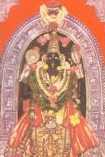
|
This temple is situated at Mardol about 1 km from the Mangueshi Temple.
Mhalasa Narayani, an incarnation of Lord Vishnu, is portrayed in a female form as
Mohini. The temple was constructed in early 16th century. The deity has been originally
from Verna and was moved to Mardol to avoid the Portuguese destruction during the early
days of the inquisition. |
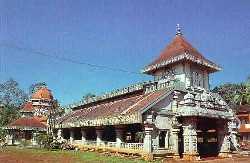 |
At the entrance to the temple
is an artistic, seven storied lamp tower, which is known as a deepstambh. Made entirely
from brass, this tower stands 12.5 metres high. During the annual
Zatra in February and on special festival days like the Navratri, the 12.5 meter
brass lamp is entirely lit. It is thought to be the largest lamp of its kind in India. The
inner hall of the temple has carvings of the 10 incarnations of Lord Vishnu that have been
resplendently painted. An embellished silver frame adorns the doorway to the sanctum.The pillars outside the temple are also exquisitely carved. The deity is
worshipped by many especially mahajans of Kaushika, Atri, Bharadwaj and Vatsa
gotras. The Goddess Mahalasa was a much feared deity and justice dispensed by taking oath
under the "Justice Bell" was recognized even by Portuguese courts. |
Shree Damodar
Temple, Zambaulim
 |
This
temple is situated at Zambaulim, about 22 kms from Margao, on the banks of the Kushawati
river. The deity was originally based in a temple at the exact spot where the Church of
Holy Spirit stands in Margao today. It was moved in 1565 AD to escape the Portuguese
inquisition when the original temple was destroyed and the Church of Holy Spirit built on
its site. The Kushawati river is believed to have great healing powers and devotees take
bath here to cure themselves of bodily ills. The main festival celebrated is Shigmo, the
Goan Hindu festival of color. |
| The Mahajans of the Temple are from
Kaunsha, Bharadwaj, Kashyapa and Vatsa gotras. |
Shree Mahalaxmi Temple, Ponda
This
temple is situated about 4kms east of Ponda. Mahalaxmi is the Goddess of power and
strength. She is believed to be an incarnation of Adishakti and worshipped by the
Saraswats who belonged to the Shakti cult. The special feature of
this deity is that she wears Lingam, a symbol of Lord Siva, on her head.
Many believe that this Goddess of tremendous strength and power, was released when the
devas and the rakshasas were churning the ocean for amrita. The migrating Saraswats to Goa
who had brought the Mahalaxmi idol with them, built a temple at Bhandawad village. The
majority of the Saraswats, however, were then living at Tiswadi and Sasasti Talukas and
had to cross a river and travel a long distance to worship the deity. |
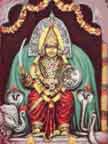
|
So they shifted the idol to
Colva, just six kilometres from Madgaon and established another Mahalaxmi temple, on the
banks of the Arabian Sea. Legend has it that she was a
favorite deity of the Kadambas and the Shilaharas, an ancient dynasty that
ruled Goa. The temple was moved from Colva, in Salcette taluka around the
inquisition to save it from destruction by the Portuguese. The "Sabhamantap" or
the main hall of the temple contains a gallery of 18 wooden images of Lord Vishnu, one of
the rarest collections of its kind in the country. The deity is the Kuldevata of Kaushika,
Kashyapa, Vatsa, Bharadwaja Gothras. |
Shree Saptakoteshwar
Temple, Narve
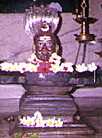 |
This small temple is situated at Narve, 37 Kms from Panaji near Bicholim.
It is dedicated to Lord Saptakoteshwara, an incarnation of Lord Siva. The deity worshipped
is the "Lingam" and is faceted and known as the "Dharalinga".
This has a long and turbulent history. The deity originally was based in a temple on
Divar Island, off old Goa. It was a much favored deity of the Kadambas, and after Goa fell
to the Muslims, the deity was buried and later a temple constructed for it on Divar
Island. When the temple was demolished in 1560 by the Portuguese, (and a chapel dedicated
to Nossa Senhora De Candelaria was erected in its place) it was used as a well shaft until
some Hindus managed to rescue it. |
The idol
was then smuggled across the river to Bicholim where it was installed in a new temple.
Sivaji, the great Maratha king, ordered renovation of the temple at its present site in
1688 during his attempt to oust the Portuguese. The Saptakoteshwar Linga of Lord Shiva is
believed to be made of seven metals and hence the name Saptakoteshwar. However, according
to folk tales, the deity is called Saptakoteshwar because he is believed to have crossed
swords with demons with his powerful army of seven crores. |
Shree
Naguesh Temple, Bandode
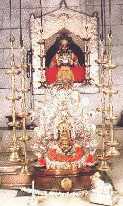
|
This
is one of the few temples which was not affected by Portuguese Persecution and continues
to be located at its original site at Bandode, 4 km east of Ponda.
The deity Lord Naguesh, is an incarnation of Lord Siva. The deity was established by the
Saraswats who came from Trihotra in the Mithila district of Bihar. The temple was
constructed in 1413 AD and was later renovated by King Shahu, grandson of Sivaji the
Great. The " Sabha Mantap " or the main hall has a gallery on either side with
images carved in wood depicting scenes from the epic "Ramayana". In the inner
shrine is a "Lingam" a symbol of Lord Siva. In front of the shrine is an image
of Nandi bull, in black stone. |


|
Beside
the temple is a five-storied lamp tower. On the lower half of the tower is brightly
painted deities. The temple also have a centuries old water tank. Shri Nagesh Temple is a
"Swayambhu" shrine of Lord Shankar known for its miraculous myths. The history
is not available at present, except a reference in the folk songs. As the legend
goes a cow-boy noticed that a cow from his herd used to visit the place regularly
and showered milk. This led to the discovery of Shivlinga.
The most important festival that is commemorated
here during the month of November is the Anguish Satrap. The Mahajans of the temple are of
Kaushiks, Vatsa and Bharadwaja Gotras. |
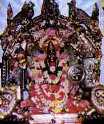
|
Shree Kamakshi Temple, Shiroda
This temple was originally
located at Raia in Salcette and was moved to its present location in 1564-1568. The temple
is located at Shiroda. It is dedicated to Goddess Kamakshi, an incarnation of Goddess
Parvati, consort of Siva. By the side of the main temple are shrines dedicated to Shree
Shantadurga, Shree Laxmi Narayana and Shree Rayeshwar. The main festival is Dusshera. The
Mahajans belong to Vatsa, Kaushika and Atri gotras. |
Shri
MahaGanapati Mahamaya Temple, Shirali
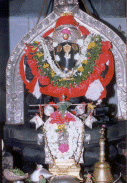 |
This is one of the Kuladevata Temples with Bhats, Puraniks, Mallyas,
Kudvas and Nayaks. The deities were in Goa in the area called Golti and Naveli. On account
of the hostile religious policies pursued by the Portuguese rulers around 1560 A.D., these
devotees left Goa. Being unable to take with them the idols, they invoked the presence of
the deities in the silver trunk of Lord Ganesha and the face cover of the mother goddess
Mahamaya and took it with them. They reached Bhatkal and being unable to construct a
temple immediately, kept these two symbols in a shop of a devotee. Later on, they
constructed a temple in Shirali where it stands today.This temple is near the
Chitrapur Mutt samsthan, Shirali. The main festival is the Car Festival on Margashira
Shudda Navami (in the month of Nov./Dec.) |
| Shree
Laxminarsimha Temple, Veling, Ponda This
temple was originally situated in Sankhavali (Sanchole in Salcette) and was shifted with
other deities Sri Vijayadurga and Sri Shantadurga to present Sylvan surroundings. The
temple is still in its old glory with wooden bars reliefs and carvings. The painting and
carvings in the temple chowka depicting Sri Narasimha Purana are worth seeing. The
Mahajans of the temple belong to Shankpinga Kutsa Gotra. There is palakhi of Sri Laxmi
Narasimha on every Shukla Chaturdashi, Sri Ramanavami, Navaratri are celebrated grandly
and annual Jatra is held in Magha Masa. |
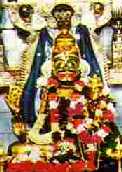
|
This temple is situated at Priol, on a hillock surrounded by green hills.
It is dedicated to Lord Mangueshi an incarnation of Lord Siva, which is recognised only in
Goa. Lord Mangesh is worshipped here in the shape of a Shiva linga.The Sri
Mangesh linga is stated to have been consecrated on the mountain of Mangireesh (Mongir) on
the banks of river Bhagirati by Lord Brahma himself, from where the Saraswat Brahmins
brought it to Trihotrapura in Bihar. They carried the Linga on to Gomantaka and settled at
Mathagrama, the present day Madgoa, establishing their most sacred and ancient temple of
Mangesh on the banks of the river Gomati or Zuari as it is called today. This location is to the south of the Zuari River where the present day
village of Cortalim stands. |
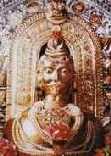
|
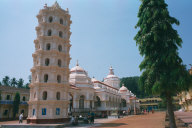 |
However, when the Portuguese took over in 1560 AD, the Saraswats of Vatsa
Gotra felt insecure fort heir deity and shifted the Mangesh linga from the original site
at the Kushasthali to Priol in Atrunja Taluka, which at that time was ruled by the Hindu
kings of Sonde. After remaining in the houses of a temple priest for sometime, the Sri
Mangesh deity was finally installed in its present site at Priol. It has undergone many
renovations and today its style is uniquely Goan. The oldest part of the temple complex is
the water tank in front of the temple. |
At the entrance to
the temple is a majestic lamp tower, one of the special architectural features of many
Goan temples. The Mahajans of the Temple are of Vatsa and Kaundinya Gotras. There is a
story in mythology about the manifestation of Lor Mangesh. Lord Siva left Kailas after
having lost everything in a game of dice against his wife, Parvati. When Parvati came
looking for him, he disguised himself as a tiger and frightened her. In a state of shock,
Parvati uttered the words, "Trahi Mam Grisha", which when translated means,
"O Lord of the Mountains, save me". Siva then reverted into his normal form and
returned with her. The words, "Mam Grisha" came to be associated with this story
and Siva came to be known as 'Manguesh'. The place where this tale occurred came to
be called Mangreesh mountain and the location was marked Lord Brahma by installing a Siva
Linga.
Shree Ramnathi Temple, Ponda
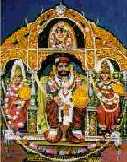 |
This temple is situated at Bandode near Ponda and is dedicated to Lord
Ramnath, an incarnation of Lord Siva. The main inner shrine has an idol of Shree Ramnathi
and has four smaller shrines of Shree Laxminarayan, Shree Shantadurga, Shree Betal, and
Shree Sidhnath. The five together constitute the Shree Ramnath Panchayatan. The Lingam in
the temple originally came from the village of Lotulim in Salcette, and was moved to the
present site in 1566 to escape the Portuguese wrath. The temple structure was renovated in
1951. |

Ramnathi Temple
|
| The main
festival centered around this temple is the "Maha Shivratri". The Mahajans of
the Temple are of Kaundinya and Vatsa gotras. |
Shree Shantadurga Temple, Kavlem
 |
This
famous shrine is situated at Kavlem and built in 1738 by king Shahu
of Satara and is the largest and most famous in Goa. It is dedicated to the goddess
Shantadurga, an incarnation of Goddess Parvati. This deity is
believed to have been carried by Loma Sharma of Kaushik Gotra when the Saraswats came to
Goa from Trihotrapura in Bihar. |
|

The temple
|
Legend say that once during a quarrel between Lord Siva and Lord Vishnu,
she appeared in the form of Durga and took Vishnu by her right and Shiva by her left hand
and pacified the two and resolved the fight. The deity is shown holding two
serpents, one in each hand, representing Vishnu and Shiva. Shanteri is then said to have
gone to Shankawali to kill the demons harassing the Brahmins there. It is for this good
deed that she also earned the name of Vijaya. The deity was shifted here from
Kelsi, to escape the Portuguese during the early days. A special feature
at this temple is that Harijans are permitted to enter the sanctum sanctorum of his temple
on magha sudha sashti as a reward for their help in giving land and welcoming the goddess
while being shifted to Kavale.
Sri Shantadurga is worshipped all over Goa and
scores of temples have been devoted to this deity. At several places she is known by
several names, Thamai, Sateri, Bhumka, Adimaya and others. The mahajans belong to Kaushika
Gotra. Shree Shantadurga or Shanteri is the most popular deity among all the kuladevatas.
There are many temples dedicated to her in Goa. |
Devaki Krishna
Ravalnath Temple, Marcela
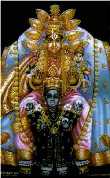 |
This temple is popularly known
as Pisso Ravalnath and located at Marcela, Ponda. The most important festival is
"Maini Paumima" in the month of Pausa (January). This seems to be the only
temple in India where Lord Krishna is worshipped with Devaki as Devakikrishna. The
Black-stone idol of Devaki in standing posture and the child Krishna is unique in Goa. The
affiliate deities are Bhumika Devi, Laxmi Ravalnath, Mallinath, Katyayani, Chodaneshwar
and Dhada Shankar. This deity is worshipped by Atri, Kasyapa, Vatsa, Kaudinya, Vasista,
Bharadwaj gotras. Ramanabami, Gokulastami are celebrated on grand scale.
During the days of religious persecution the
deity was shifted from Chorao, Tiswadi to Mayem in Bicholim and from there to the present
location at Marcel. |
Kalbhairav Temple,
Harihareswar, Maharashtra
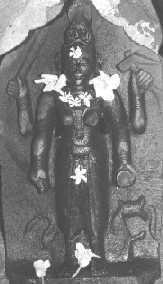 |
The famous
Kalbhairav temple is in the temple town of Harihareshwar 230 Km from Mumbai on the
Mumbai-Panvel-Goregaon Konkan coastal highway. According to Puranas Shri Kalbhairav is
considered to be the chieftain of the spirits created by Shri Mahadev. It is believed that
a devout Siva saint discovered four self-formed lingam in this place. In Konkan and
Gomentak there are a number of Kalbhairava Temples. It is believed that if one remembers
Kalbhaira at the time of going to bed, one is free from all ill effects of the
spirits.
Even the Time (Kal) is scared of the Bhairav.
Deity Bhairav is therefore named Kalbhairav. This has been mentioned by Shri
Shankaracharya in his Kalbhairavastak. |
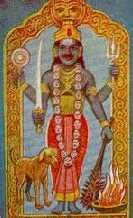
|
|